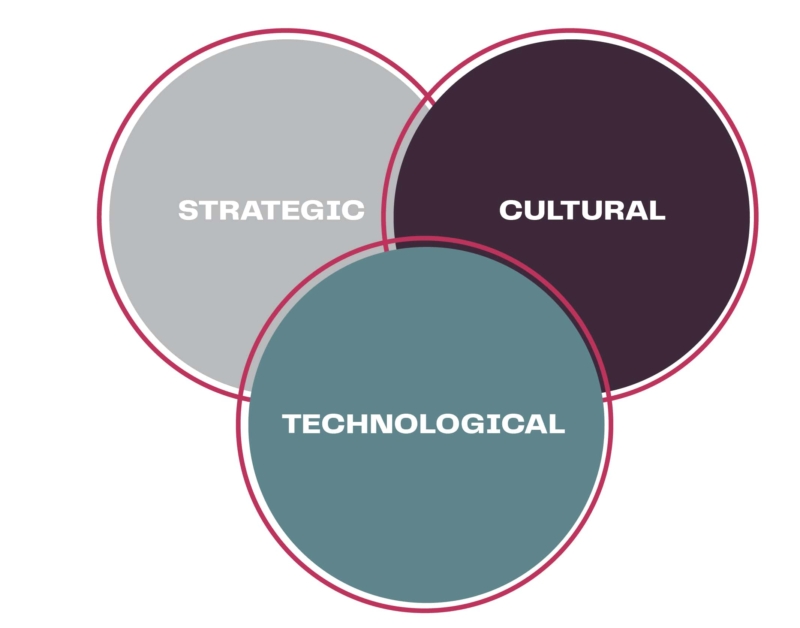Manufacturing has been undergoing a massive digital transformation. As a result, factories look very different from those of the past. Technology has facilitated efficiency in supply chain optimization, real-time feedback from intelligent sensors, and analytics to give managers the information they need to produce quality products at a lower cost. In addition, using technology like artificial intelligence and machine learning enables organizations to spot trends and detect patterns to better understand their production processes.
This chapter looks at the impact of digital transformation and how it improves the quality of your products and creates customer loyalty.
Chapter 4: Advanced Quality Management for Dummies
Presenting Industry 4.0
You’re probably familiar with the term “Industry 4.0.” It refers to the idea of a fourth industrial revolution currently underway. Depending on whom you talk to, the phrase carries a variety of definitions extending into the realm of the “smart factory” or “smart manufacturing.” What it may mean for you is that significant technological advances have made it possible to take major leaps toward your organization’s digital transformation goals, bringing you closer than ever to your customers and suppliers.
The first three industrial revolutions encompass the journey from the introduction of steam and water power, to the rise of factory production lines, to the use of computers and automation. Market leaders who embrace Industry 4.0 are positioned to realize technology’s full potential.
To pick a representative definition from many, PricewaterhouseCooper describes Industry 4.0 as “the end-to-end digitization of all physical assets and integration into digital ecosystems with value chain partners.”
So, let’s look at one of these digital innovations PwC hints at.
Data and analytics are one area of innovation at the heart of digital transformation. The ability to break down silos and collect and analyze data from across the organization enables the discovery of critical insights and better decision-making. Real-time data analysis allows teams to more easily spot trends, track quality improvements, and respond proactively to emerging problems.
Delving Into Quality 4.0
Quality 4.0 has emerged to keep pace with the sweeping changes resulting from Industry 4.0. LNS Research coined the concept of Quality 4.0 in 2016. The aim of Quality 4.0 is for organizations to build on the best advances in technology to become more customer-centric throughout the product lifecycle. The tools of Quality 4.0 include:
- Cloud computing
- Big data analytics
- Artificial intelligence and machine learning
- Smart sensors
- Automation
- Mobile devices
- Internet of things
- Culture of quality
- Moving quality upstream
One of the critical developments of Quality 4.0 is that it helps move quality upstream. What does that mean? Previously, quality inspections and the problems they uncover were relegated to the end of the manufacturing process when it was too late to make changes without costly delays.
By integrating QMS software earlier into the new product development process, your organization becomes proactive based on manufacturing optimization, supplier quality, and customer feedback. Organizations can assess and monitor problems throughout the manufacturing process, and therefore avoid potential delays or, worse, a recall. Companies can establish metrics and bench- marks to analyze product plans across the entire organization.
One of the things that the development of Quality 4.0 uncovered was the lack of qualified talent to support Quality 4.0 efforts. This is a challenge that organizations have yet to overcome. A solid training component in an advanced QMS will help skill-up and retain quality staff.
Working virtually
The disruptions caused by the COVID-19 pandemic forced manufacturers to address a host of new business continuity issues, namely the ability for employees to do their jobs remotely. Traditional paper-based processes were not only inefficient but simply not feasible in the new reality. Organizations quickly turned to mobile and cloud-based solutions to rebuild business processes.
QMS software with mobile device capabilities made activities like remote auditing possible. Cloud-based software enables users to access the right information when and where they need it, regardless of the employee’s physical location and device type. Mobile capabilities are just one more example of technology’s role in Industry and Quality 4.0 initiatives.
ADOPTING QUALITY 4.0
According to executives in a 2019 survey by Boston Consulting Group (BCG) in partnership with ASQ and the German Association for Quality (DGQ), the adoption of Quality 4.0 should be done as quickly as possible. They state that:

Focusing on Automation
Quality professionals know the value of automation in alleviating administrative overhead and increasing efficiency. The follow- ing sections examine some of the essential quality processes to include in your automation strategy.
Document control
Core to any QMS software solution is a document control function to manage all your documents in a centralized framework. Make sure your QMS solution has:
- Collaborative cloud-based document control
- Documents in a single location that can be accessed anytime, anywhere
- Defined workflows of processes and procedures
- The ability to integrate with other enterprise apps
Training management
- Training employees is elemental to establishing and maintaining a culture of quality. Make sure your QMS solution:
- Has a 360-degree view of employee training
- Manages employee training requirements
- Integrates with the document management solution
- Adapts to the unique training and certification needs of each organization
Audit management
Audit management is a crucial core application to provide control over the entire auditing process. Make sure your QMS solution has:
- All components of the audit management system in a single location
- Streamlined phases for audit scheduling, assigning, executing, and reporting
- Mobile device capability to allow for multiple modes of auditing (including offline)
Suppliers, materials, and chemicals management
Organizing your supplier information and requirements for the chemicals and materials they send you is key to minimizing risk and resolving issues down the line when deliverables don’t meet your standards. Make sure your QMS solution can:
- Track supplier goods in real-time
- Manage nonconformances and delayed deliveries
- Collect supplier rating information
- Integrate with your ERP system to automate information exchange and keep your database clean
Tracking, trending, and acting on quality events
Nonconformances, otherwise known as quality events, are defined in ISO 9001 as any nonfulfilment of requirements. These events can negatively affect the quality, performance, safety, or reliability of your products and services. Consistently tracking and investigating all nonconformities is a good practice for continuous quality improvement. Consider if your QMS software will help you to:
- Capture any nonconformity to your quality systems, even beyond products and services
- Establish a workflow to investigate and conduct a risk assessment to determine if a corrective action is needed
- Track and trend nonconformances outside of the CAPA process and discover potential systemic issues
- Drive root cause analyses
Corrective and preventive action (CAPA)
Applying automation to the corrective action process keeps every stakeholder apprised of who needs to do what and when. To sup- port these time-critical workflows, make sure your QMS software solution will:
- Prioritize, filter, track, and execute corrective actions on internal and external supplier findings (SCARs)
- Improve accountability and visibility
- Quickly and automatically bring attention to resolving adverse events
Handling nonconformance
Product and service nonconformances reflect the performance of your core business operation. To effectively manage these failures, make sure your QMS software solution can:
- Connect to risk assessment, corrective action, and supplier corrective action (SCAR) workflows
- Keep track of deviations throughout the process
- Integrate customer feedback into the nonconformance handling processes
Future-Proof Quality
The unexpected nature of the COVID-19 pandemic and its over- whelming impact brings into focus the wisdom of future-proofing for quality. Although many companies consider themselves ready for the future, that’s not always the case. As a result, things like quality management can sometimes be put on a back-burner. However, those businesses that kept quality management in the forefront could avoid closing plants and laying off workers during a disruptive time such as the pandemic.
Here are some lessons manufacturers learned about quality and digital transformation from the pandemic:
Automation is key to transforming physical tasks. Manufacturers can reduce the number of people needed for physical tasks (like inspections) by automating manual processes during a crisis. In addition, automated data processes ensure that no valuable data is lost.
The cloud is essential. The cloud knocks down physical barriers, thus making physical limitations almost irrelevant. A view into a supplier’s inventory is possible regardless of location. Employees can be based anywhere, so talent is easier to find.
The imperative to incorporate quality into every digital transformation is now squarely in focus.
Each week we will share with you a chapter in the book. If you’d prefer to read the book at your own pace download here.



